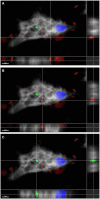Isolation and Genome Analysis of an Amoeba-Associated Bacterium Dyella terrae Strain Ely Copper Mine From Acid Rock Drainage in Vermont, United States
- PMID: 35677904
- PMCID: PMC9169046
- DOI: 10.3389/fmicb.2022.856908
Isolation and Genome Analysis of an Amoeba-Associated Bacterium Dyella terrae Strain Ely Copper Mine From Acid Rock Drainage in Vermont, United States
Abstract
Protozoa play important roles in microbial communities, regulating populations via predation and contributing to nutrient cycling. While amoebae have been identified in acid rock drainage (ARD) systems, our understanding of their symbioses in these extreme environments is limited. Here, we report the first isolation of the amoeba Stemonitis from an ARD environment as well as the genome sequence and annotation of an associated bacterium, Dyella terrae strain Ely Copper Mine, from Ely Brook at the Ely Copper Mine Superfund site in Vershire, Vermont, United States. Fluorescent in situ hybridization analysis showed this bacterium colonizing cells of Stemonitis sp. in addition to being outside of amoebal cells. This amoeba-resistant bacterium is Gram-negative with a genome size of 5.36 Mbp and GC content of 62.5%. The genome of the D. terrae strain Ely Copper Mine encodes de novo biosynthetic pathways for amino acids, carbohydrates, nucleic acids, and lipids. Genes involved in nitrate (1) and sulfate (7) reduction, metal (229) and antibiotic resistance (37), and secondary metabolite production (6) were identified. Notably, 26 hydrolases were identified by RAST as well as other biomass degradation genes, suggesting roles in carbon and energy cycling within the microbial community. The genome also contains type IV secretion system genes involved in amoebae resistance, revealing how this bacterium likely survives predation from Stemonitis sp. This genome analysis and the association of D. terrae strain Ely Copper Mine with Stemonitis sp. provide insight into the functional roles of amoebae and bacteria within ARD environments.
Keywords: Dyella terrae; Stemonitis sp.; acid rock drainage; amoeba-associated bacterium; amoebae.
Copyright © 2022 Giddings, Kunstman, Moumen, Asiama, Green, Delafont, Brockley and Samba-Louaka.
Conflict of interest statement
The authors declare that the research was conducted in the absence of any commercial or financial relationships that could be construed as a potential conflict of interest.
Figures





Similar articles
-
Seasonal Ely Copper Mine Superfund site shotgun metagenomic and metatranscriptomic data analysis.Data Brief. 2020 Sep 8;32:106282. doi: 10.1016/j.dib.2020.106282. eCollection 2020 Oct. Data Brief. 2020. PMID: 32984474 Free PMC article.
-
Characterization of an acid rock drainage microbiome and transcriptome at the Ely Copper Mine Superfund site.PLoS One. 2020 Aug 12;15(8):e0237599. doi: 10.1371/journal.pone.0237599. eCollection 2020. PLoS One. 2020. PMID: 32785287 Free PMC article.
-
Dyella agri sp. nov., isolated from reclaimed grassland soil.Int J Syst Evol Microbiol. 2017 Oct;67(10):4246-4252. doi: 10.1099/ijsem.0.002291. Epub 2017 Sep 18. Int J Syst Evol Microbiol. 2017. PMID: 28920848
-
The Ecology and Evolution of Amoeba-Bacterium Interactions.Appl Environ Microbiol. 2021 Jan 4;87(2):e01866-20. doi: 10.1128/AEM.01866-20. Print 2021 Jan 4. Appl Environ Microbiol. 2021. PMID: 33158887 Free PMC article. Review.
-
Amoebae as a tool to isolate new bacterial species, to discover new virulence factors and to study the host-pathogen interactions.Microb Pathog. 2014 Dec;77:125-30. doi: 10.1016/j.micpath.2014.07.009. Epub 2014 Jul 31. Microb Pathog. 2014. PMID: 25088032 Review.
References
-
- Abramoff M., Magalhães P., Ram S. (2004). Image processing with ImageJ. Biophoton. Int. 11, 36–42. doi: 10.1201/978142000561 - DOI
-
- Alanjary M., Kronmiller B., Adamek M., Blin K., Weber T., Huson D., et al. . (2017). The antibiotic resistant target seeker (ARTS), an exploration engine for antibiotic cluster prioritization and novel drug target discovery. Nucleic Acids Res. 45, W42–W48. doi: 10.1093/nar/gkx360, PMID: - DOI - PMC - PubMed
LinkOut - more resources
Full Text Sources
Other Literature Sources
Molecular Biology Databases
Miscellaneous

